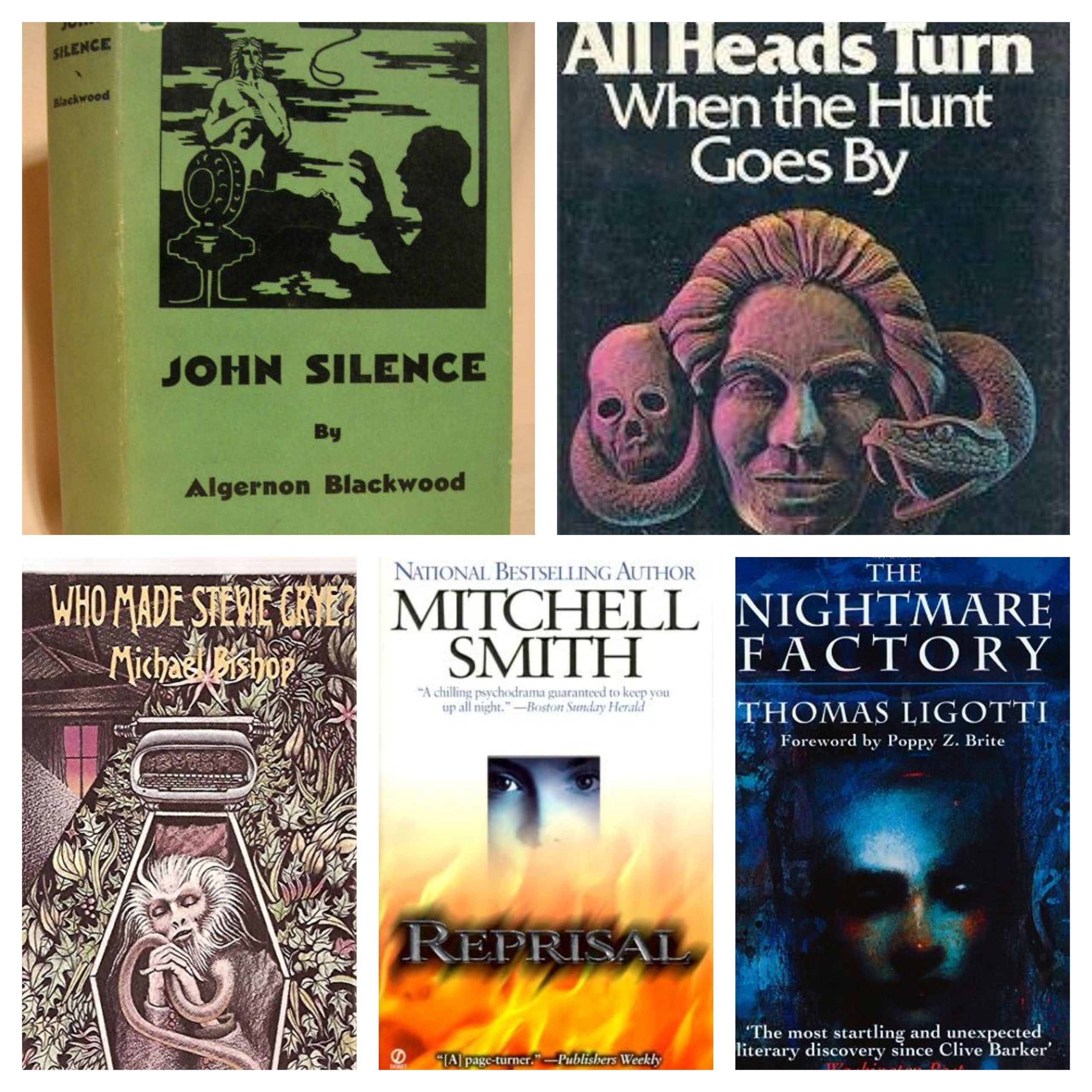It’s May! Spring has sprung and those hits just keep on coming. In this installment, we have a classic paranormal detective, a family dynasty steeped in voodoo, a heavily meta demon-possessed typewriter, a tale of revenge and spelunking and a massive omnibus of weird fiction from a particularly unique writer. We got ourselves a whole heap of fun in store so let’s just keep movin’ on.
For those just joining me, this is my journey through the following “Best of” Horror lists:
Reedsy Discovery Best Horror Books
Stephen Jones & Kim Newman’s Horror: 100 Best Books
Stephen Jones & Kim Newman Horror: Another 100 Books
If you want to check out my previous entries, they can be found here:
Part 36 | Part 35 | Part 34 | Part 33 | Part 32 | Part 31 | Part 30 | Part 29 | Part 28 | Part 27 | Part 26 | Part 25 | Part 24 | Part 23 | Part 22 | Part 21 | Part 20 | Part 19 | Part 18 | Part 17 | Part 16 | Part 15 | Part 14 | Part 13 | Part 12 | Part 11 | Part 10 | Part 9 | Part 8 | Part 7 | Part 6 |Part 5 | Part 4 | Part 3 | Part 2 | Part 1
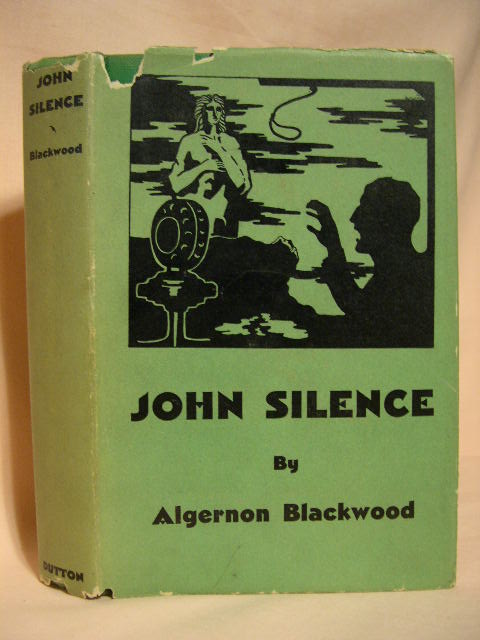
John Silence, Physician Extraordinary (Algernon Blackwood, 1908)
List: Jones/Newman
Here’s one I’ve been meaning to get around to for quite some time. A writer I often enjoy, Blackwood gives us his own particular weird spin on the occult detective. Included in the version I read is all six of the John Silence stories published (five were included in the original 1908 edition with a shorter story “A Victim of Higher Space” being written later and included in all future editions). The first thing to call out with John Silence is to note the “physician” reference in his title. You see, rather than being a traditional ghost hunter like that of Carnacki or many others from around this time, Silence approaches these cases from a physician’s standpoint, seek to heal his patients’ psychical or metaphysical disturbances, rather than traditional ailments. The six stories, five of which are more substantial novellas, run the gamut from more standard ghostly hauntings to witchcraft to Ancient Egyptian sorcery to werewolves and all other manner of strange incidents.
The first story in the collection “A Psychical Invasion” offers a more traditional ghost story on the outset, but the means by which Silence employs to be rid of the haunting are rather odd, using his dog and cat as his primary implements of healing. The story has some interesting ideas but honestly I felt the setup took way too long to really get going (unfortunately a common occurrence with Blackwood at times).Next up we have “Ancient Sorceries”, by far the most anthologized of these tales, and with good reason. This is Blackwood pulling out all the stops with a story of a strange village full of some truly weird witchcraft-related shenanigans. It’s easy to see how this was an influence on H. P. Lovecraft. Oddly enough, John Silence doesn’t actually do much in this one with most of the narrative being one long story being told to Silence by this other idea who experienced all this craziness. Definitely one of the best stories in the collection. Going way back to my write-up on Bram Stoker’s Jewel of the Seven Stars, I lamented the lack of good mummy-related stories. Well, Blackwood gives us a solid one here with “The Nemesis of Fire”. In this one Silence investigates a secret Egyptian tomb beneath a seemingly haunted manor troubled by a rogue fire elemental. We have the ever-familiar trope of the séance but here Blackwood gives it new life by blending it with ancient Egyptian mysticism. One of the highlights for me. “Secret Worship” involves Silence exploring a ghost of the past tormenting a remote monastery. This one seems to be well-regarded but honestly, it’s another one that I felt took too long in its setup. Once we get to the monastery though, the climax is quite satisfying. “The Camp of the Dog” evokes similar vibes of some of Blackwood’s most well-known stories like “The Willows” and “The Wendigo”, as we follow people out in nature, being hounded by a werewolf. This was an interesting one that really showcases Silence’s talents as a psychical investigator, deducing a truly strange twist on the lycanthropy myth. Another very good story with Blackwood doing what he does best. The final tale in the collection “A Victim of Higher Space” feels almost like an afterthought, being MUCH shorter than any of the other stories. Even so, it’s still an entertaining story of a man who uncontrollably is pulled into the fourth dimension against his will at random. I liked it fine but it’s not one of the strongest stories in the collection. Overall though, I really enjoyed these stories and definitely recommend them to fans of occult detectives with “Ancient Sorceries”, “The Nemesis of Fire” and “The Camp of the Dog” being some of the best out there.
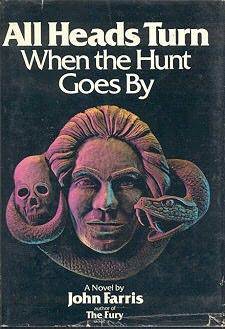
All Heads Turn As The Hunt Goes By (John Farris, 1977)
List: Jones/Newman
We open with a military wedding for Clipper Bradwin full of lush pageantry and genteel southern manners in the 1940s. This sacred ceremony is cut short when the groom, Clipper, snaps and murders multiple people in the middle of the wedding including the bride-to-be and the head of the family, “Boss” Bradwin. After the bloodbath that interrupts the wedded bliss we jump forward in time and across the pond to English where we are introduced to ostensibly our main character, a British man named Jackson who is tasked with caring for Clipper’s brother, now an invalid with PTSD symptoms returned from war. What unfolds is a complex and oddly structured tale that acts as a far-reaching family saga of the Bradwins that slowly mutates into a sinister tale of occultism and voodoo in the Deep South.
You know, beyond that opening wedding slaughter, this book is a pretty hard one to summarize, hence the fairly short summary above. It doesn’t follow a typical three-act structure, instead jumping back and forth in time and from place to place, from Virginia to England to Arkansas to Congo and beyond, all the while slowly planting seeds of the dark family secret that is causing all the misfortune the Bradwins have been suffering through the years. At times, it almost feels rudderless in its plotting but Farris knows what he’s doing, weaving together a kind of rich tapestry only so it’ll look all the more pretty when it burns to ashes. What I will say is that Farris has a real knack for building three-dimensional characters that are unique and interesting to live with even when nothing overtly scary is happening. While this is definitely a real slow-burn (at least after that initial jolt), it does pay off by the end, building to a very dark and sinister climax that, while I was able to predict to a certain extent, still was quite well done. Overall, I’m not sure I’d call this absolutely essential reading, but it’s still very good.

Who Made Stevie Crye? (Michael Bishop, 1984)
List: Jones/Newman
Stevie Crye is a recently widowed mother and struggling author. To make matters worse, her spiffy new typewriter is broken, and the company that manufactures it wants to charge her an arm and a leg to get it fixed. Fortunately, her friend a local doctor, knows a little local typewriter repair shop that can get it fixed it no time at a fraction of the cost. It’s at this repair shop where she meets a young oddball wunderkind of typewriter repair named Seaton who not only fixes it in a jiffy but even “makes it better”. It’s too bad that Seaton’s idea of making it better is imbuing the typewriter with demonic powers that harness Stevie’s dreams to terrify her. Plus Seaton has that damn capuchin monkey, and it’s always around, being filthy, spying, drinking blood from Seaton’s finger… Can Stevie, with aid from a local psychic, escape from this metafiction nightmare and live to write another day?
I enjoyed this one a whole lot. Michael Bishop is more known for his sci-fi and fantasy, and while there are certainly elements of both in this, it certainly plumbs the more horrific aspects of how a demon-possessed typewriter may manifest its torments and wreak havoc on a grieving and frustrated woman’s life. The book is HIGHLY meta at times with it being unclear if what you are reading is the actual story or what the typewriter is writing. Seaton, as a possible villain, never really seems to pose much of a threat (then again…maybe he isn’t supposed to) but that damn capuchin is kinda creepy. I don’t really want to talk about this one too much since part of the pleasure is just in watching the story/story with and without/within a story unfold. I will say though that the copy I have is a very nice hardcover released by Arkham House complete with suitably unsettling illustrations peppered throughout. While I can see the meta aspects of this book being a little polarizing, I personally liked it a great deal and recommend checking it out if it sounds like your cup of tea.
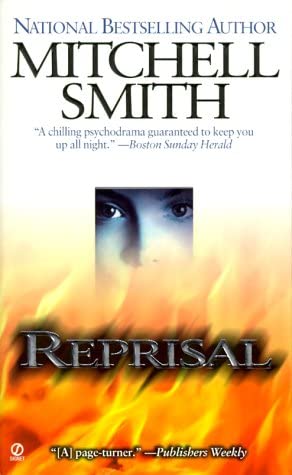
Reprisal (Mitchell Smith, 2000)
List: Jones/Newman
Joanna Reed is still dealing with the fallout of surviving breast cancer when we meet her. Right off the bat, we witness her husband Frank lured out to sea and drowned by a young woman named Charis who we also discover is Joanna’s daughter’s roommate at college. While Joanna is still trying to process her grief from losing her husband and dealing with the unsympathetic local law enforcement, Charis meanwhile kills Joanna’s father as well, and like Frank, stages it as an accident to throw off the authorities. Joanna’s grief just keeps spiraling with only her intense hobby of caving to seek solace in. As Charis seeks to destroy everything Joanna loves, will Joanna discover the dark secret that drives Charis to commit these atrocities?
Well, this just wasn’t very good, a very curious misstep of a recommendation from the second Jones & Newman book. The book for the most part is neither scary nor particularly interesting for the majority of its page count. Smith spends a great deal of time focused on Joanna’s day-to-day in the wake of tragedy, at times feeling almost like a book version of Chantal Akerman’s Jeanne Dielman, 23, quai du Commerce, 1080 Bruxelles. We witness Joanna cooking, cleaning, going to the store to buy groceries, going to the bathroom (a lot…like to the point that Smith seems obsessed with describing women going to the bathroom…anyway I digress) and all the other mundane tasks we don’t normally see captured in a novel, all while Joanna wrestles with her intense grief. Over the course of a 400+ page book, these scenes grow to be extremely dull and repetitive. Smith also pretty much starts the book with Charis killing Joanna’s husband, dispelling any mystery that might have been drummed up in the course of the narrative. Instead of the question of “who”, it becomes a question of “why”. And to be quite honest, that answer is both predictable and not terribly interesting or rational. One area where this book does actually succeed is in its caving sections. It’s obvious Smith either does it himself or did a lot of research beforehand because the level of detail in describing the process of spelunking and more importantly the exhilaration and danger of crawling into dark, tight spaces completely alone where one false step could mean a slow, lonely death by starvation in the dark, are captured quite well. This helps the climax of the book leave a better aftertaste from the novel that it might deserve otherwise. Overall, outside of the caving sections which are quite well done, this just felt like a clunkily written and dull misfire that really doesn’t belong on any list of best horror novels.
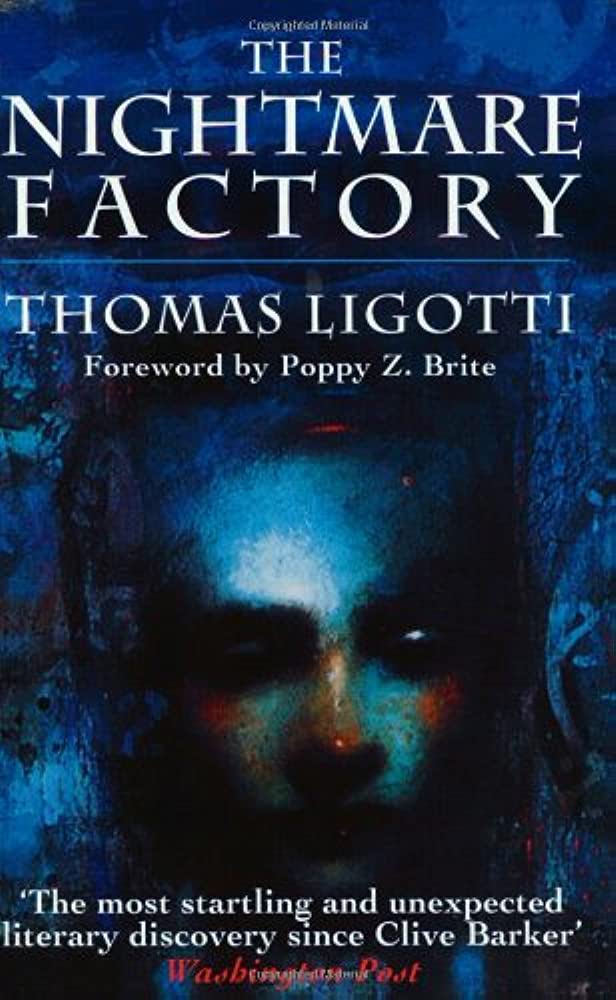
The Nightmare Factory (Thomas Ligotti, 1996)
List: Jones/Newman
This massive tome collects stories from Ligotti’s collections Songs of a Dead Dreamer, Grimscribe, Noctuary and Teatro Grottesco. With a giant compendium, it’s hard to even know where to begin discussing it. His prose is dense and mysterious, often evoking a dream-like state of unreality. His characters are often plagued by mental illness, haunted by the past or is instilled with some inherent trait that often leaves them into a rabbit hole of insanity and doom. Ligotti excels at creating a dark and foreboding atmosphere with a writing style that feels at times as if you are trapped in some kind of hellish dance you can’t escape from. He is fascinated by a specific kind of theatricality with clowns and puppets but twisted into a kind of sinister nightmare. The best of his stories are able to take these concepts and create something truly disturbing and magical. Stories like the false memory horror of “Gas Station Carnivals”, the bizarre hypnotism tale “Drink To Me Only With Labyrinthine Eyes”, the Lovecraftian folk horror of “The Last Feast of Harlequin”, the absolutely fascinating tape recording performance art weirdness of “The Bungalow House”, the creativity-killing revelry of “Teatro Grottesco”, they show Ligotti at his absolute best, showcasing a dizzying and perplexing cornucopia of dream-like imagery fused with brilliant and mysterious prose. At times Ligotti has a tendency to let his more obscure tendencies get the best of him though, with some stories being frustratingly unresolved or too obtuse to get a narrative hold on. At times, Ligotti’s stories have a very dark and strange flow to them that evokes someone like David Lynch (If Lynch were ever to adapt Ligotti, that’d be a match made in heaven) and is wholly unlike any other writer out there. Some may at first as a knee-jerk response want to compare Ligotti to Lovecraft, and while Ligotti certainly has some thematic similarities, Ligotti is a much more insular author, trapping the reader in a mental hellscape of their own devising. Many of Ligotti’s stories are not of the conventional or crowd-pleasing variety, but if you can slow down and let them sink under your skin, there’s an embarrassment of riches here.

